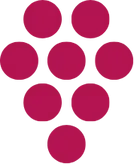E-Label Masterguide
In our master guide, you will find a compact and easily explained overview of the most important contents of the new EU Regulation (EU) 2021/2117 for wine products, as well as the answers to the most frequently asked questions of many winegrowers, such as What are the mandatory details on the back label? Which vintages are affected by the new EU regulation? How big does the QR code have to be? And much more.
Introduction
On December 8, the new EU Regulation (EU) 2021/2117 for wine products comes into force, which states that all nutritional values and ingredients must be made transparent. This can be provided in the form of QR codes as a so-called "e-label". This measure requires changes to be made to wine labels, order lists and the online store, which raises many questions for winegrowers. What is the mandatory information on the back label? Which vintages are affected by the new EU regulation? How big does the QR code have to be?
That is why IMERO, in collaboration with wine law expert Dr Eichele and Duilio Cortassa, has developed the e-label.eu software solution, which enables winegrowers to implement the new EU regulation as quickly and easily as possible.
Here you will find an overview of the most important contents of the new regulations, as well as the FAQs we receive from winegrowers.
What does the new EU regulation say?
From December 8, 2023, all wines produced for sale in the EU must be labeled in the same way as other foods. This means that the indication of nutritional values and ingredients on wine labels will be mandatory. The full list of ingredients in the nutritional table can be made available via e-labels - these are QR codes on the label that are linked to a mobile website. Software solutions such as e-label.eu from IMERO offer simple and secure creation and management of these mobile websites.
When do the regulations apply?
The regulation applies from December 8, 2023 and concerns wines that are considered produced after this date.
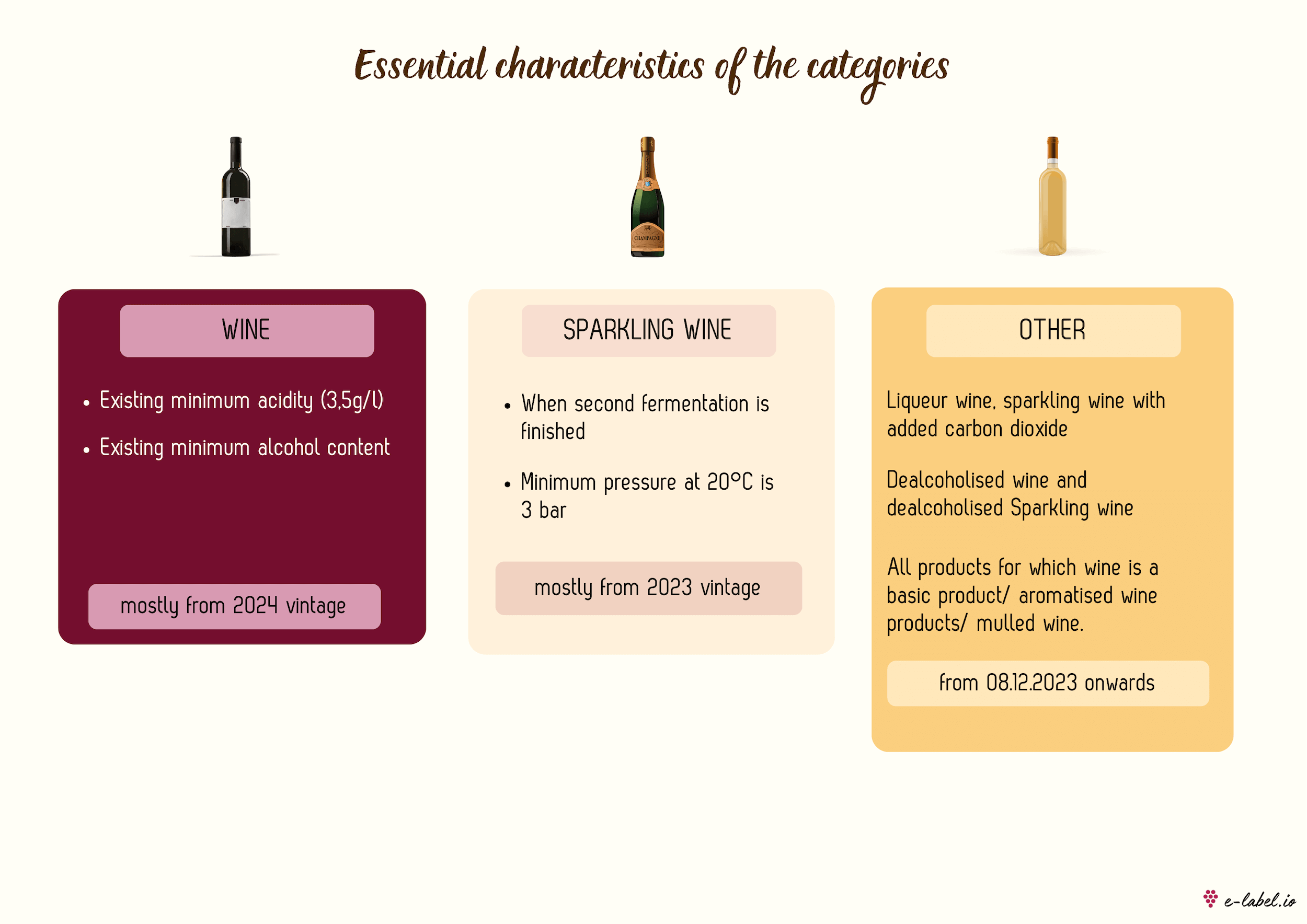
Regardless of the date of production, however, retailers may need the information on the wines much earlier. They must provide the information on your online store and in your catalogs. It is therefore advisable to create the information for your wines as early as possible. With the e-label.eu software, you can then share all the relevant information with your distributors with just one click.
What measures need to be taken?
Products such as wine, sparkling wine, semi-sparkling wine, non-alcoholic wine and aromatized wine must be provided with a nutritional table and a list of ingredients from 8 December 2023. The physical label on the wine bottle must continue to include the following information Allergens - in all languages, energy content, fill quantity, alcohol content, vintage, bottler, winery and product name. The QR code, which should be at least 1cm x 1cm in size, then refers to the e-label with detailed information on ingredients and nutritional declaration.
What information must be displayed on the e-label?
The following information is mandatory:
- The wine must be clearly identifiable (name of the wine plus an optional picture)
- Nutritional information for 100 ml
- Energy content in kj and kcal (this must also be stated on the bottle label)
- Information on carbohydrates and sugar in grams
- Information on fat, unsaturated fatty acids, salt and protein, which can be presented either in tabular form or as text such as 'Contains negligible amounts of fat, saturated fatty acids, protein and salt'
- The full list of ingredients with the ingredients to be declared according to EU
- Allergens
- Recycling details must also be provided for export to Italy
- Additional details such as grape varieties, quality and logos are optional
Advantages of QR codes (e-labels)
The QR code is not a flash in the pan, but is firmly anchored in the regulation and is here to stay.
QR codes have several advantages: Firstly, the 1 x 1 cm QR code offers a very space-saving solution without compromising the label design. Secondly, the QR codes are dynamic, which means that the information behind the QR code can be updated at any time. This is particularly important as laboratory data is often not yet available when labels are printed. Thanks to the dynamic QR codes, however, the data can be added at any time. Thirdly, QR codes also enable very simple integration into the web store and on price lists.
Specific requirements for e-labels
There are specific requirements that e-labels must fulfill:
- Language
- The mandatory information must be written in a language that is easy for the consumer to understand. Accordingly, the ingredients and the nutritional table must be provided in an EU language, e.g. German. e-label.eu from IMERO offers a user-friendly translation option in 24 languages.
- No marketing content
- The EU regulation explicitly prohibits showing marketing content on the e-label itself or selling your wines. Therefore, your e-labels should be hosted separately from your website and online store.
- No user tracking
- Comprehensive tracking of users, e.g. using cookies for tools such as Google Analytics, is not permitted. However, an analysis of the scan rate or a rough localization of the scans via the IP address is possible. IMERO works with legal experts so that you can sit back and relax while we ensure that data protection is maintained.
- Unlimited validity
- The e-label must remain online for as long as the product is on the market. Our paid plans offer a standard term of 10 years, which can be extended upon request.
- One e-label per vintage
- A new e-label must be created for each new wine with different laboratory values or a different list of ingredients.
- Recycling
- Currently, it is mandatory to include information on recycling in Italy or all manufacturers that supply/sell to Italy.
How to implement your e-label with e-label.eu from IMERO
With e-label.eu, IMERO has specialized in the needs of the wine industry and created a software that enables winegrowers to create an e-label for their wine in just a few steps and thus implement the EU regulation in a legally compliant manner.
Anyone can use our tool within 5 minutes without any prior knowledge. Create your e-label in 4 simple steps:
- Log in
- Visit our website www.e-label.eu and enter your details to create your e-label.
- Upload nutritional information and ingredients used.
- Upload your lab results and select the ingredients you use. All the data and images for the wine are already in your ERP system or in the store? The IMERO interfaces allow easy import into the e-label. We take care of the rest.
- Create and download an e-label
- Download the 'dynamic' QR code. The stored data can be adjusted afterwards, the printed code always remains the same.
- Attach the QR code and lean back
- Provide your wine labels, wine brochures and sales shelves with the e-label/QR code. Your e-label complies with all legal regulations in all sales countries and is dynamically adapted to legal changes.
Ingredients
In Regulation EU 2019/934 (see Table 2), the EU has specified which additives and processing aids may be used in the production of wine. Only the additives must also be declared as an ingredient.
The table has over 100 entries and over half of the substances do not have to be specified. We have therefore made it easy for you in our software. A clickable list shows all the additives that could be in your wine. Please select the ones you use from this list. Everything else does not have to be declared.
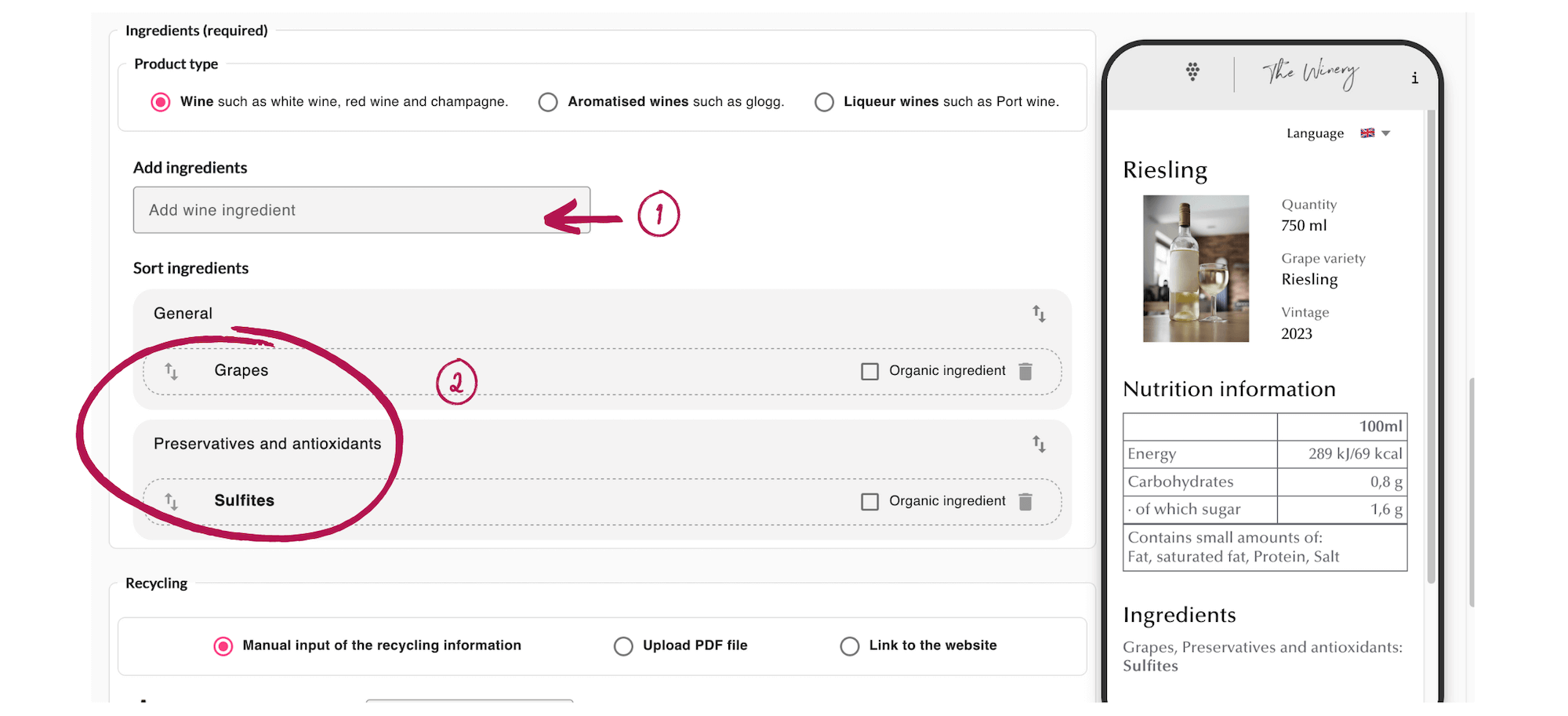
For flavored wines and liqueur wines, you must specify the ingredients you use in addition to the wine.
Nutritional information
In addition to the calorific value, only carbohydrates and sugar play a role in wine. Fats, salts and proteins can be indicated as 0g or as a "negligible amount" for classic wine.
But how do you calculate the calorific value, carbohydrates and sugar? The good news is that a standard laboratory report with alcohol content, acidity and residual sugar is completely sufficient. Our e-label software automatically calculates all the necessary values from this.
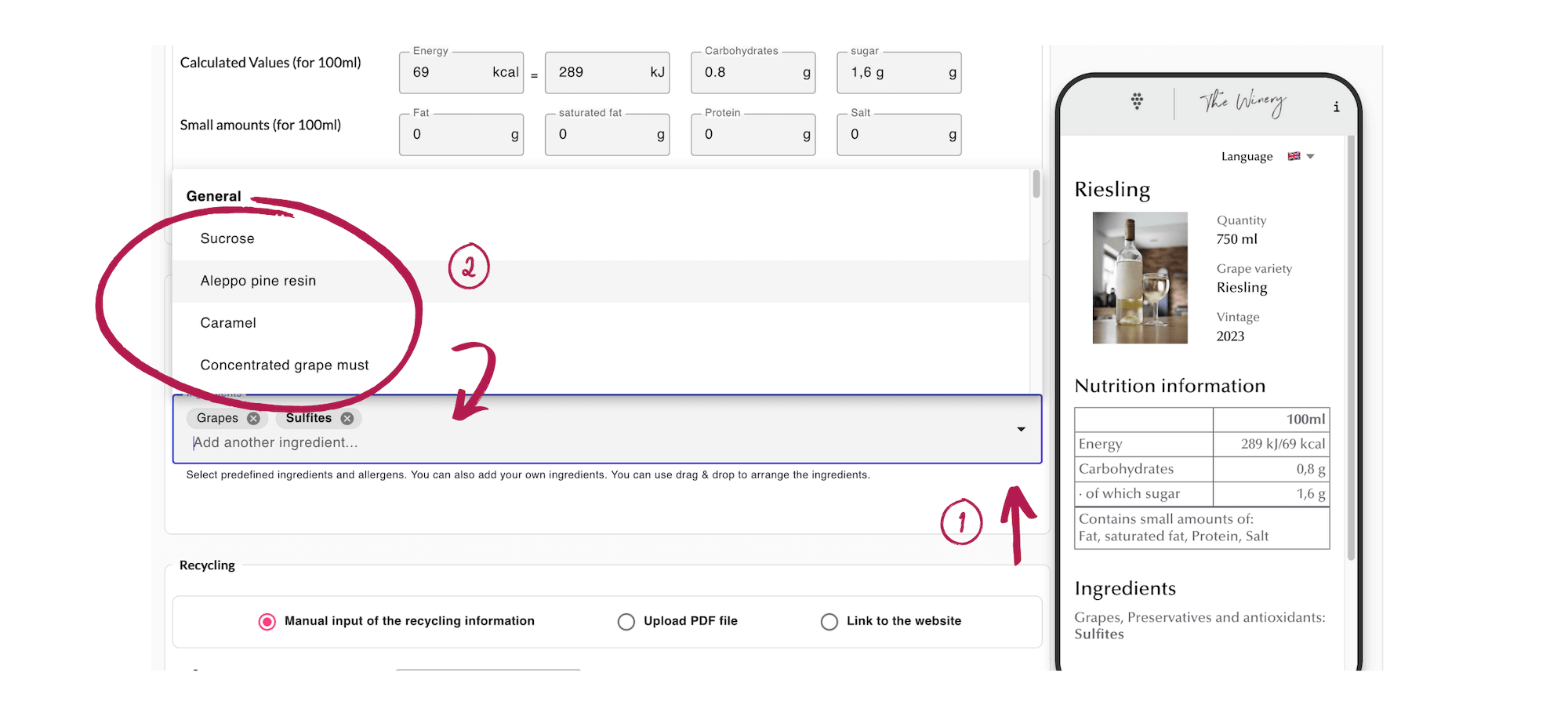
We use the following values to calculate the kcal:
- 1g alcohol = 6.96 kcal (29 kJ)
- 1g sugar = 4.08 kcal (17 kJ)
- 1g organic acid = 3.12 kcal (13 kJ)
- 1g extract, glycerine = 2.4 kcal (10 kJ)
- 1 kcal = 4.186 kJ
The formula is also based on the factor specified in Regulation (EU) No 1169/2011 for foodstuffs. This specifies the factors that can be used to calculate the energy values (see page 62).
What needs to be considered when printing?
The "quiet zone" or "border" surrounding the QR code should be at least 4 module sizes.
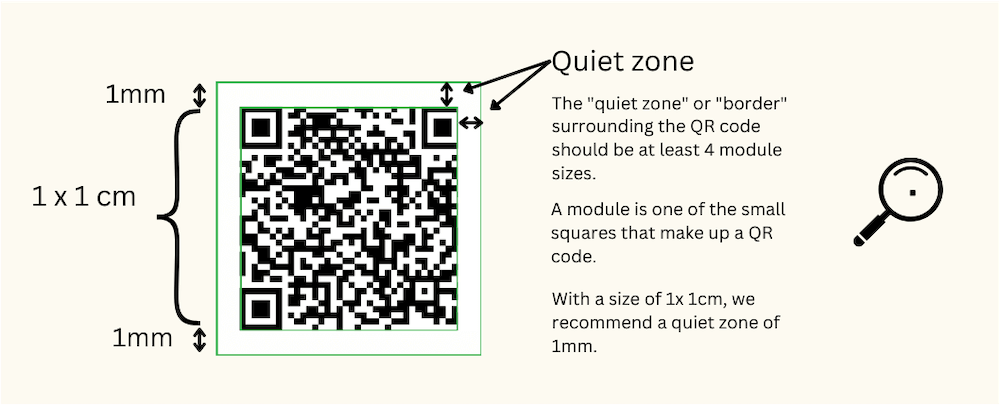
A module is one of the smallest squares that make up a QR code.
For a size of 1x1cm, we recommend a quiet zone of 1mm.
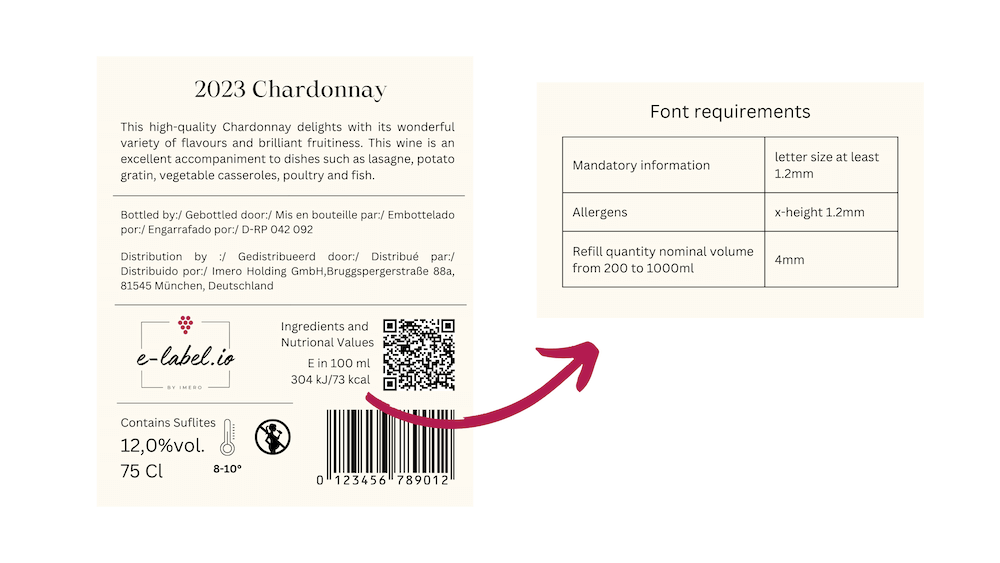
The legibility of the labels must be guaranteed. Therefore, a minimum font size of 1.2 mm applies to the prescribed information (with the exception of the nominal filling quantity). This applies regardless of the font used. For the indication of allergens, a font size with an x-height of at least 1.2 mm is prescribed.
The use of collective QR codes in catalogs, price lists and web stores
According to the EU Wine Label Regulation (2021/2117), each wine must be assigned a specific QR code, at least for the back label. This means that it is normally necessary to provide a separate QR code for each wine. But what does this look like for extensive price lists with many different wines?
Here, the legal text allows the option of using one QR code per page instead of many different ones. A collection of the listed wines can then be linked behind this one QR code.
These special QR codes, which cover several wines, are called 'collective QR codes'. They make it possible to bundle information on different wines and thus ensure greater clarity on the price list. You can find out more in our blog article.
In the following video, we show you how to use the IMERO collection QR code function:
